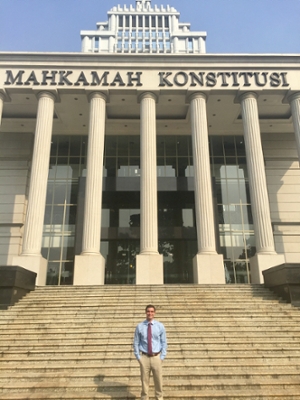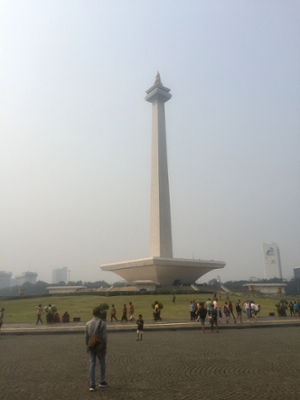Jakarta
Last week I arrived in Jakarta where I will spend a little less than a month working with the Constitutional Court of Indonesia. Thus far my internship has felt a lot like a journalism project, as my only deliverable is an article fit for international publication due at the end of my time in Indonesia. I thought that the Court would change this feeling by giving me administrative work and using me in a traditional law clerk role, but after my first day I learned that it is the exact opposite. The Constitutional Court is one of the two highest courts in all of Indonesia and in many ways it is comparable to the Supreme Court of the United States. For those of you who have been following my blogs weekly (hi Mom), I covered the Constitutional Court’s jurisdiction in another post. Regardless, the Court is instrumental to national governance in Indonesia. Yet, during my time here the senior researchers will be helping me collect data for my article. Once again, I am feeling more like a journalist than a summer legal intern. I certainly have no complaints about this, as the substance of my article will be highly elevated by the unrestricted access to Court information provided by the internal researchers and clerks.

Coming from Padang to Jakarta made me feel like I actually left for another country. Padang is one of the most conservative Islamic provinces in Indonesia, and Jakarta does not follow suit. Additionally, there are many more westerners around Jakarta, as it is the capital city. So far, I have met reporters, journalists, construction workers, and business people from all over the world. During my time in Jakarta I will also have access to NGOs focused on constitutional law and elections. In the middle of the city is the national monument, which is meant to symbolize Indonesia’s independence. The monument is picture below.

I was able to tour the Constitutional Court’s museum, which documents the entire legal history of Indonesia. The museum highlights the nation’s independence from the Dutch and the original Constitution from 1945, and then also the Constitutional Amendments that were completed in 2002. These amendments created the Constitutional Court, which now serves as the “guardian of the Constitution”. Interestingly, the museum had some American legal background that inspired the Court. This includes a tribute to the United States Supreme Court case Marbury v. Madison, which inspired the Constitutional Court’s judicial review power.
I also had the opportunity to interview one of the sitting Justices, I Dewa Gede Palguna, who is from Bali. Justice Palguna was a gracious host, who is very educated on the American legal system, citing several famous Supreme Court cases in our discussion. He was also willing to answer all of my questions, regardless of the amount of detail required. We spoke at length about the nature of the civil law status of Indonesia, and how progress in the country’s democracy has to come from a change in the law or an amendment to the constitution. When I asked about the election systems specifically, Justice Palguna was able to give me an inside perspective on how the justices decide the cases. One of the things about the election disputes that I highlight in my article is the margin requirement for a losing candidate to have standing to bring a case. In order for a losing candidate to assert that there was a miscount in the election, they have to finish within a certain percent of total votes. While it varies depending on the population and type of local election, the candidates cannot bring a local election challenge to the Court if they lose the election by more than 2%. This strikes me as problematic, because one way that an election count could be incorrect is due to corruption or money politics. Therefore, if a candidate rigs an election really well, and wins by a 2.1% margin, then the losing candidate has no avenue to bring the case to the Constitutional Court challenging the final vote count. In these local election cases, the Constitutional Court only has the authority to review cases challenging the final vote results, or “recapitulation”. Election crimes and other offenses lie with the Supreme Court or Administrative Courts. These courts, however, have not been as progressive as the Constitutional Court in solving election issues. The Constitutional Court has even expanded its power in deciding these cases to the benefit of democracy. Before the national government granted the Court jurisdiction over the election dispute cases in 2008, the Supreme Court only solved mathematical issues involving miscounts of the ballots. Today, the Constitutional Court looks into the process of the elections and has ordered new elections when corruption in the election process was the cause of an incorrect final vote count. Yet, even with this expanded authority, the candidates have to meet the margin to bring a challenge. Justice Palguna explained that the main rationale for this margin is to ensure that frivolous election challenges are not common. Justice Palguna explained that the peaceful transition of power is critical to any democracy.